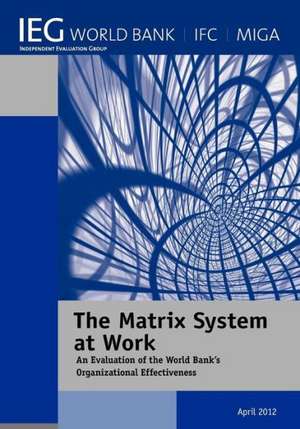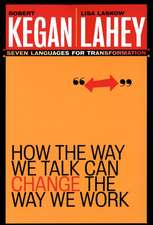The Matrix System at Work: An Evaluation of the World Bank's Organizational Effectiveness: Independent Evaluation Group Studies
Autor The World Bank, World Bank Publicationsen Limba Engleză Paperback – 30 iun 2012
Din seria Independent Evaluation Group Studies
-
 Preț: 204.17 lei
Preț: 204.17 lei -
 Preț: 212.45 lei
Preț: 212.45 lei -
 Preț: 211.50 lei
Preț: 211.50 lei -
 Preț: 237.76 lei
Preț: 237.76 lei -
 Preț: 280.41 lei
Preț: 280.41 lei -
 Preț: 243.15 lei
Preț: 243.15 lei -
 Preț: 220.13 lei
Preț: 220.13 lei -
 Preț: 243.15 lei
Preț: 243.15 lei -
 Preț: 217.62 lei
Preț: 217.62 lei -
 Preț: 203.61 lei
Preț: 203.61 lei -
 Preț: 238.14 lei
Preț: 238.14 lei -
 Preț: 277.69 lei
Preț: 277.69 lei -
 Preț: 238.14 lei
Preț: 238.14 lei -
 Preț: 171.19 lei
Preț: 171.19 lei -
 Preț: 207.05 lei
Preț: 207.05 lei -
 Preț: 167.51 lei
Preț: 167.51 lei -
 Preț: 237.37 lei
Preț: 237.37 lei -
 Preț: 236.95 lei
Preț: 236.95 lei -
 Preț: 204.67 lei
Preț: 204.67 lei -
 Preț: 202.76 lei
Preț: 202.76 lei -
 Preț: 234.86 lei
Preț: 234.86 lei -
 Preț: 178.96 lei
Preț: 178.96 lei -
 Preț: 227.75 lei
Preț: 227.75 lei -
 Preț: 241.56 lei
Preț: 241.56 lei - 13%
 Preț: 159.43 lei
Preț: 159.43 lei
Preț: 243.69 lei
Nou
Puncte Express: 366
Preț estimativ în valută:
46.63€ • 48.82$ • 38.58£
46.63€ • 48.82$ • 38.58£
Carte tipărită la comandă
Livrare economică 07-21 aprilie
Preluare comenzi: 021 569.72.76
Specificații
ISBN-13: 9780821397152
ISBN-10: 082139715X
Pagini: 264
Dimensiuni: 178 x 254 x 17 mm
Greutate: 0.54 kg
Ediția:New.
Editura: World Bank Publications
Seria Independent Evaluation Group Studies
ISBN-10: 082139715X
Pagini: 264
Dimensiuni: 178 x 254 x 17 mm
Greutate: 0.54 kg
Ediția:New.
Editura: World Bank Publications
Seria Independent Evaluation Group Studies











